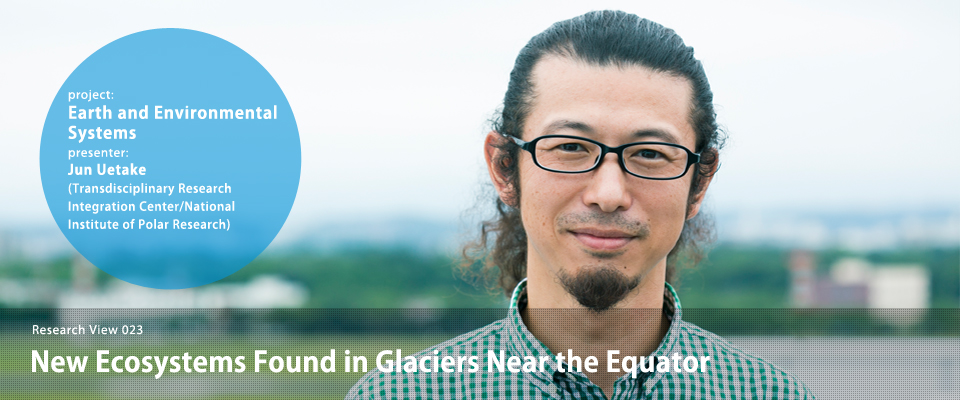
Even in tropical regions located directly on the equator there are mountains featuring glaciers. Such mountains include the 5,895 meter-high Mount Kilimanjaro (Tanzania), the 5,199 meter-high Mount Kenya (Kenya), and the 5,109 meter-high Mount Rwenzori, which is located on the border of Uganda and the Democratic Republic of Congo. Glaciers were first observed on Mount Rwenzori in 1906; a glacier 6.5 km2 in size was found near the summit. However, this glacier has been decreasing in size over the past 100 years, and it is even predicted that it will completely melt by 2020. Project researcher Jun Uetake (Transdisciplinary Research Integration Center/National Institute of Polar Research) discovered aggregates of moss gemmae near the summit of this disappearing glacier, and reported on his observations in a press release in November 2014. Here, we introduce his latest observations and results.
Small black lumps of moss scattered across glacier surfaces
Compared with the other two African mountains, precipitation is higher at Mount Rwenzori, and the vegetation is richer. It is approximately a five-day walk to the summit. At the beginning of the walk, the vegetation is the sort of jungle specific to tropical regions, but as you walk up, it becomes a cloud forest covered by moss and lichen, followed by afro-alpine moorland which have peculiar shapes and only live in high African mountains. At altitudes above 4,500 meters, vegetation gradually appears on scattered rocks, and eventually the glacier referred to as the Stanley plateau becomes visible. This glacier is about one kilometer in length, which is small for a glacier, but it is largest on this mountain. When we visited the glacier, we found black lumps around one centimeter thick covering its surface. We were impressed by its oddness. When we picked some up to take a look, we found that it presented a structure of interwoven fiber-like cells. We then decided to bring samples back to Japan for study. At first, we thought that they were green algae such as "Marimo" (Aegagropila linnaei) because of their single-cell structure, like microbes when viewed through a microscope. The results from genetic analysis, however, showed that they were actually mosses. The cells, which we thought were microbes, were at a stage referred to as "gemmae", a natural part of a moss life cycle, so we named this lump "glacial moss gemmae aggregation (GMGA)." However, I personally call them "glacial nuggets" because they look just like chicken nuggets. (Laughter)

Mountain vegetation prepared by glacier ecosystems
The glacier nuggets are "mossy aggregates" in which organic matter is produced through photosynthesis. This matter is then converted or degraded by microbes. Each glacial nugget contains a complete ecosystem in itself. Further, glacial nuggets appear black due to substances such as humus, which are produced by the microbes. The black color absorbs light, and as a result the glacial ice melts as mosses spread. Observations showed that the glacier is retreating by two to three meters every year. There were many dried glacial nuggets on rocks that used to be covered by glacier ice. There were other types of moss and grass on the top of the older glacial nuggets. In other words, glacial nuggets are producing substances that serve as the basis of high mountain soil. In addition to Mount Rwenzori, we are starting to investigate the Arctic region for ecosystems following the retreat of glaciers.

Observing the terminus of Greenland Icesheet
Satellite photos of Greenland, which is located in the Arctic region, show that most of its surface is covered by ice. When you go to the borders between the ice sheets and land, you will find that it is covered by black granules smaller than glacier nuggets, around one millimeter in diameter. They are called "cryoconite granules", and they are made of tangled microbes called cyanobacteria, which are commonly seen in extreme environments. Here, too, the melting of glaciers is driven by "black" aggregates of organisms which prefer cold environments. Moreover, such areas are expanding into Greenland's ice sheets every year, inducing a rise in the sea level due to the melting ice from this large area. This is of great concern today.

Checking for microbes in the atmosphere
For both Mount Rwenzori and Greenland, we think that it is important, in addition to understanding the ecosystem on the glaciers, to investigate what is coming in and going out of the systems. One of the key aspects in this problem is the transport of microbes by wind. Unlike human or animal transport, the wind can carry and spatially distribute microbes far. As a result, its effect on ecosystems is likely to be significant. Thus, we are preparing to collect air samples and their genetic analysis in order to find out how much of which microbes can be found. Because this type of an observation has not been conducted in either polar regions or in cities like Tokyo, we are testing the method by installing a device on the roof of our institute.

(Text in Japanese: Jun Uetake, Rue Ikeya. Photographs: Toshiaki Kitaoka. Published: September 10, 2015)





